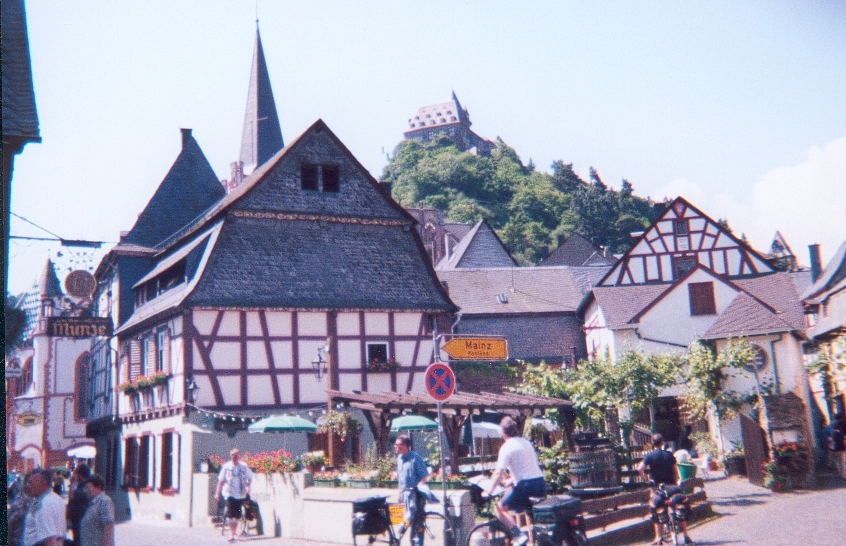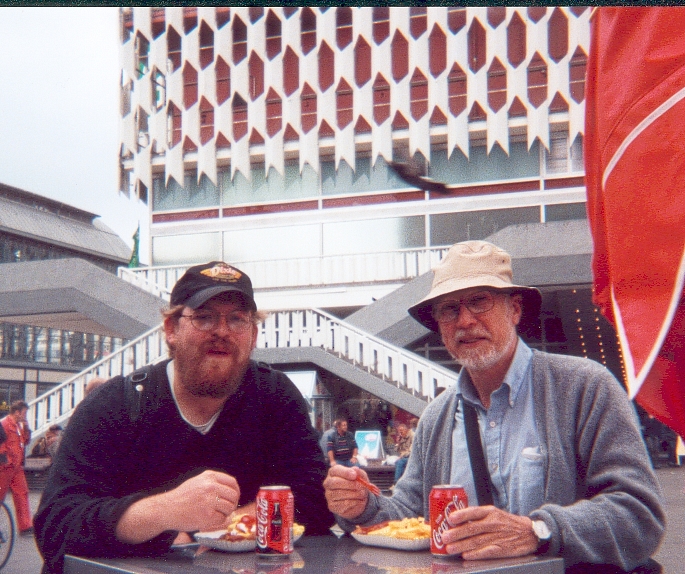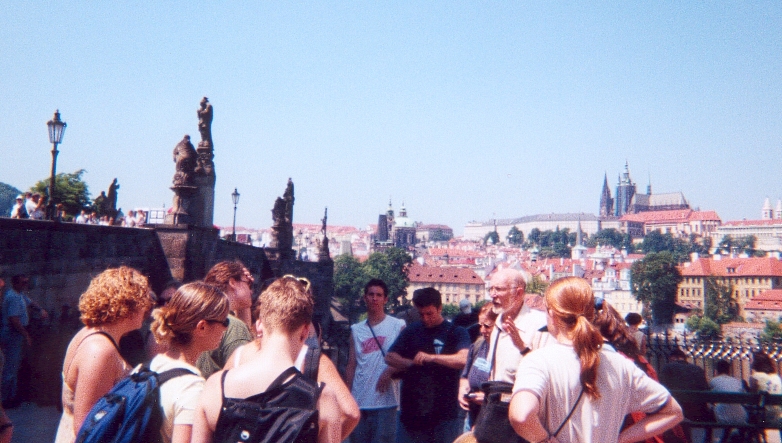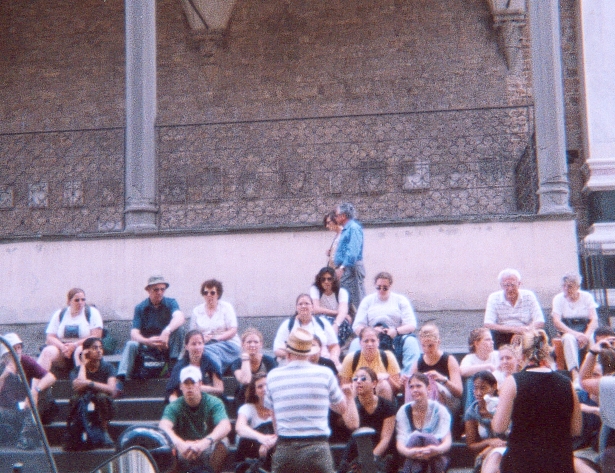
Summer Trip 2000 with ECHT
Group A began its adventure in Cambridge, England. By the end of the second night most of us had recovered from jetlag, had learned a good many names, and were into some of the course material.
LONDON We did all the major museums--the national gallery, the new Tate, the Imperial War Museum (a real sleeper. Great!), the British Museum and the Tower.
We saw the Tempest at the Globe, not knowing ahead of time that Vanessa Redgraves was playing Prospero. She was ok.
BRUSSELS
Bill (Professor Urban, as he was called by everyone on the tour) had been in Brussels thirty-five years ago, but he and Jackie had been too tired to see much. They had spent the previous night on a channel ferry and the day at a festival in Brugges. This was much better. The central city was very attractive, and Bill was able to visualize easily the English hooligans rioting there a few weeks later during the European soccer championships that he saw almost in their entiriety on tv during the trip.
PARIS Louis Kincannon delayed a trip to China to spend a day with Bill. They visited Chateau de Vicomte, a lovely chateau with a marvelous garden and fountains.
The group did all the outstanding museums--the Louvre, the Musei d’Orsay, the Pompidou, les Invadiles, the Rodin. Lovely cool weather.
VERSAILLES We toured the public rooms and walked through the gardens all the way to Marie Antonnette’s little village. Since it was a Sunday, we experienced the combination of fountains playing and music from the era of Louis XIV.
BACHARACH After an overnight train ride to Frankfurt, we stopped briefly in Rudesheim, then took a boat down the Rhine. The walk up to the youth hostel in the castle was a strain, but we all made it; and we all agreed that it was a great place to stay. The students loved the quiet of the Rhine valley after two weeks of busy capital cities.
We stayed in the castle overlooking the Rhine in Bacharach.

Mathias Betyna and Hanna came down from Düsseldorf to pay a visit.
The idyllic pause in the lectures and museum visits was soon over. The wine tasting became only a memory, but an easily remembered one, remembered more fondly than the scramble up the hill with full pack on the day of arrival. We were quickly back on the capital cities route. Next BERLIN.

Tour manager Jeremy Baldwin and Prof Urban eating currywurst at Alexanderplatz in Berlin. Below: the students at what remains of the Berlin Wall at Potsdammerplatz.
Bill lectured on the wall and the collapse of communism in 1989-1990, part of which he had witnessed personally. The students had read The Spy Who Came In From the Cold, which had begun in London’s Bayswater district (where we had stayed) and ended at the Wall. We toured the area along the former wall, which is now a gigantic construction zone, the Reichstag, the Soviet War Memorial (which Putin visited the next week), the Art Gallery, the Historical Museum (which was being renovated, so only two exhibits were available), and the romantic art and Egyptian museums at Charlottenburg. Also, the Pergamon Museum.
POTSDAM Bill at the Chinese pagoda, where we ate a slightly illegal lunch (on the grass) and visited the Neues Palais (1767). Checkpoint Charlie Museum was much enlarged this year, and less crowded.

DRESDEN
This was Bill’s first visit since 1990.
What a difference! This was a beautiful
city, with flowers and shops, and the church
almost restored from the 1945 bombing.
The Zwinger was a fantastic art gallery.
Alas, we had so little time.
PRAGUE
Beautiful as ever, and still affordable. The only disadvantage was that this year’s trip was a day shorter.
Right, lower. Bill lecturing next to the Charles Bridge, describing Bohemia’s medieval importance. We went up to the castle later.

VIENNA Schönbrunn Palace was this year’s main
stop for the history class, with the city historical museum a close second. But
it was art history that held stage center. One evening we had tickets to Verdi’s
Jerusalem at the Opera house. A great performance.
MUNICH Not much of a memory, since Bill was sick the entire visit. Hey, it happens. But that's why it's wise not to travel alone.
VENICE
Going south of the Alps to escape the heat sounds odd, but that was our experience. It was warmer in Venice, by a degree or two, but the humidity was less and we had a sea breeze.
PADUA We got off the train on the way to Florence to see Giotto’s masterpiece.
FLORENCE Home again, in a sense. Bill had lived in Florence 1974-1975.
Bill saw a little notice in the paper that the Persus was to be unveiled at 6 PM. The intent was clearly to keep the tourists from swamping the event. So he and Jay went to see it. The speakers, however, went on so long that Bill had to return to the hotel to set up the wine tasting (mainly Chianti).
He knew there would be a parade on the 24th (St. John’s Day), so he and some others were in place to see it. Once again, no publicity. Florentines don't want tourists to ruin their private celebrations.
There was a special Giotto exhibit at the Accademia. But everyone was much more impressed by Michelangelo’s David. Not the equal of the murals in Padua.
At the Bargello and Santa Croce in Florence.


Bill slipped out of the farewell dinner to catch the overnight train to Munich, where he met Jackie at the airport (another long story). They then spent two enjoyable weeks visiting friends in Ulm, Dusseldorf, Koln and Marburg/Lahn.
Hardly had they gotten home before they were off again, to visit parents, relatives and friends in Texas.
Reflections on the summer:
The Eastern Michigan Cultural History Tour, group A, was in several senses the most unusual I’ve ever accompanied. First of all, it was heavily female (22 young women, 4 males). Perhaps I should have expected that this would happens someday. Women have long been more likely to participate in summer study programs in Europe (going back to the Grand Tour of the nineteenth century) and now they comprise 55% of all college students. Still, this was an extraordinary percentage. The other ECHT programs were not so lopsided.
Second, I got to see some places I had not seen for twenty-five years—Cambridge, which I had visited on an all-too-short day trip to see a friend who had been at the party where Jackie and I had met; and Brussels, which we had sort of seen after an overnight ferry trip across the channel and a long day at the big festival in Brugges. This time Brussels was much more pleasant. Cool weather and no crowds. Later in the summer we could visualize the situation as English hooligans rioted in the twisting streets of the old city, supposedly attending the European soccer championship, but generally not having bothered to buy tickets. More important, I learned how good Belgian beers really were.
Third, the visits to friends along the way. It was to be the last opportunity to see a college friend in Paris, since he will be retiring from his post with the European Community and returning to America. He put off one day a trip to China to be there when I arrived, and only the rain kept us off his rooftop garden, with the view of the nearby Eifel tower. The students kidded me about having a friend in every town, but one does tend to collect friends across a lifetime, and a wise person never lets a good one go. A long-time friend even brought his daughter to Bacharach, a romantic castle on the Rhine that was our home for two nights.
Fourth, the students were very good at adapting to travel. They liked to celebrate, and they could always find an excuse for a party. Even twenty-first birthdays were marked by American-style drinking, though it made little sense to celebrate reaching the legal age to consume alcohol, since in Europe the age limit is set far younger, and most Europeans are taught from childhood on how to drink in a civilized manner. The students learned to get up at early hours when necessary, hoist their packs on their backs, and find their way to the train station. The tour manager, Jeremy, always started right on time, every time, and consequently never left them under the impression that they still had another five minutes, or ten. In the end, we never had to leave anyone behind. They always caught up, huffing and puffing. Quickly enough their physical conditioning improved. By the time we reached Florence, nobody complained about carrying everything up four long flights of stairs.
The climb to the castle at Bacharach, early in the trip, was the greatest physical challenge. But the view was worth it, and the quality of the food gave us little reason to go back down quickly, even though the romantic streets and the restaurants had much to offer at reasonable prices. Thanks to the youth hostel’s well-chosen variety of local wines, the wine tasting went well; the students learned that there was more to wine than screwing off the top and going to it.
It was white wine in the Rhineland and red in Florence. But each evening was a delightful success, even for those who preferred one over the other, and a few still went more for quantity than for quality.
Traveling with interesting and congenial companions is always a joy. The professional staff (Jeremy, Jay) had been everywhere, or were catching up fast (Jess). They had no end of stories of past adventures and fond anecdotes of students who had been on past tours. American students with backpacks are literally everywhere in Europe. However, they often don’t know exactly what they are looking at or why they are supposed to look at it. That’s the nicest thing about an art history tour—the students get much more than a survey of Europe’s cheapest beers and wines. They become experienced travelers, with a more sufficient background in art and history, and having learned how to find food and housing, use the local transportation, master the essential vocabulary in seven countries, and acquire tremendous self-confidence. Observing the swift development of these skills is the last, and most important, pleasure of summer teaching.